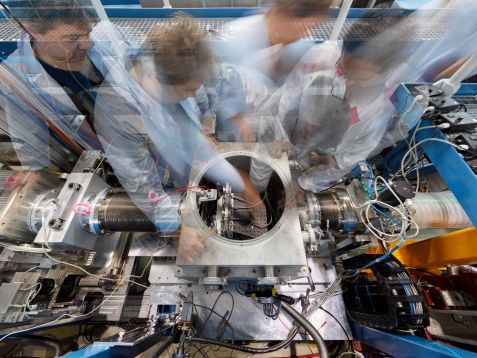MLZ is a cooperation between:
 > Technische Universität München
> Technische Universität München > Helmholtz-Zentrum Hereon
> Helmholtz-Zentrum Hereon
 > Forschungszentrum Jülich
> Forschungszentrum Jülich
MLZ is a member of:
 > LENS
> LENS > ERF-AISBL
> ERF-AISBL
MLZ on social media:

MLZ (eng)
Lichtenbergstr.1
85748 Garching
13.09.2021
Skin-like material developed for wearables

Research using the small angle scattering instrument KWS-3 located at the outstation of the Jülich Centre for Neutron Science at the Heinz Maier-Leibnitz Zentrum in Garching. © Bernhard Ludewig
Scientists at Forschungszentrum Jülich and Donghua University in Shanghai, China, have demonstrated a skin-like synthetic material intended to advance the development of so-called “wearables”, as well as smart clothing and artificial skin for robots. Neutrons from the Heinz Maier-Leibnitz research neutron source helped them to study the new material in detail.
The proton-conducting synthetic material, a so-called elastomer, is far better than previous materials at replicating the elasticity of skin and its self-healing powers as well as its ability to stiffen when stretched. Up until now, these properties were difficult to obtain in one and the same material. This has now been made possible by combining two dynamic networks that interact with each other but react differently when under strain.
Wearables, miniature networked computers that are worn on the body, have been steadily growing in use over many years. Athletes, for example, use them to train precisely within their optimal performance range, and diabetics can use them to measure blood sugar levels. Numerous other applications are feasible if even smaller and more powerful sensors and devices can be developed that are more durable and comfortable to wear, such as those incorporated into clothing. Moreover, robot technology would also benefit from materials that can mimic the tactile functions of skin and are similarly hard-wearing.
Material has to be robust and remain stretchable
The focus of this search centres on materials that are both elastic and robust, including among other things the ability to stiffen when under strain. Strain-stiffening means that a material becomes more stable when it is deformed. Many soft materials react in this way. In biological systems, this property protects against damage caused by excessive deformation. This often involves a combination of a strain-stiffening network of biological polymers in which other soft components are embedded.
The research team analysed the microscopic structure of materials at the small-angle scattering facility KWS-3, which is operated by the Jülich Centre for Neutron Research at the Heinz Maier-Leibnitz Zentrum. In the process, they uncovered correlations between the structure and the desired properties.
Scientists are looking for ways to apply the concept to ion-conducting materials to enable new functionalities for wearables. However, most synthetic ionic conductors are strain-softening. For stretchable ionic conductors, there is often a conflict between elasticity, self-healing and strain-stiffening. In particular, the chemical binding properties responsible for self-healing are often difficult to reconcile with those that enable strain-stiffening. The former requires stable chemical bonds, whereas the latter requires bonds that can dynamically dissolve and re-structure. The researchers have now succeeded in resolving this conflict by drawing inspiration from biology.
Neutrons reveal record-breaking properties
The scientists from Shanghai produced mixtures, each made up of two polymer networks with mutually complementary properties. One network dissolves specific chemical bonds more quickly when subjected to strain than the second, which in its turn enables a complete reorganisation to take place, back into the original structure.
Such experiments had already been performed, but in trials the researchers found a material with record-breaking properties. “Our best elastomer demonstrates ultra-high elongation of 1600%, excellent elastic recovery, strain-stiffening by an estimated factor of 24, and almost 100% self-healing,” Dr. Baohu Wu, instrument scientist at the small angle scattering instrument at KWS-3, is pleased to report. “The presence of zwitterions also gives the ionic elastomers advantages in terms of protection from moisture and freezing temperatures, allowing the elastomers to stably conduct protons even in harsh conditions.”
Original text: Angela Wenzik / JCNS
Original publication:
Zhang, W., Wu, B., Sun, S. et al. Skin-like mechanoresponsive self-healing ionic elastomer from supramolecular zwitterionic network. Nat Commun 12, 4082 (2021). DOI: 10.1038/s41467-021-24382-4
Further information:
Performance data of the neutron small angle scattering instrument 3 (KWS-3): https://mlz-garching.de/kws-3/
Press contact:
Angela Wenzik
Science Journalist
Forschungszentrum Jülich
Tel. +49 2461 61-6048
Email: a.wenzik@fz-juelich.de
MLZ is a cooperation between:
 > Technische Universität München
> Technische Universität München > Helmholtz-Zentrum Hereon
> Helmholtz-Zentrum Hereon
 > Forschungszentrum Jülich
> Forschungszentrum Jülich
MLZ is a member of:
 > LENS
> LENS > ERF-AISBL
> ERF-AISBL
MLZ on social media:


